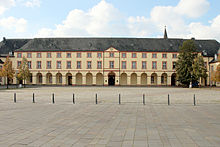House Nassau-Siegen
The house of Nassau-Siegen is a line of the house of Nassau and emerged from the Ottonian line of the house of Nassau in 1303 alongside the lines of Nassau-Hadamar and Nassau-Dillenburg . In 1328 it inherited the possessions of the House of Nassau-Dillenburg and was named after it from then on. In 1341, the Nassau-Beilstein line split from this.
During this time there was with Count Heinrich III . of Nassau the first count of the new state:
- 1308–1343: Heinrich I of Nassau-Siegen , formerly Heinrich III. from Nassau
As a result of Heinrich III. of Nassau-Siegen there were the following ruling counts:
- 1343–1350: Otto II.
In 1606 the Nassau-Siegen house split off from the Nassau-Dillenburg house. In 1652, Emperor Ferdinand III. the Count Johann Moritz in the imperial prince status . In 1734 it was united with the House of Orange-Nassau . During this time there were ten counts, from 1652 princes of Nassau-Siegen:
- 1609–1623: Johann VII. , Also: Johann the Middle
- 1623–1638: Johann VIII. , Also: Johann the Younger
- 1638–1674: Georg Friedrich
- 1674–1679: Johann Moritz
- 1679–1691: Wilhelm Moritz
- 1691–1699: Johann Franz Desideratus
- 1699–1707: Wilhelm Hyacinth
- 1707–1722: Friedrich Wilhelm Adolf
- 1722–1734: Friedrich Wilhelm II.
A well-known, if not recognized by the family, member of this line was the adventurer Karl Heinrich von Nassau-Siegen (1743–1808). This was allegedly a grandson of Immanuel Ignaz von Nassau-Siegen (1688-1735)
The Principality of Nassau-Siegen included the present-day localities of Freudenberg , Hilchenbach , Kreuztal , Siegen , Netphen and Wilnsdorf , and at times also the present-day village of Burbach . In the north it bordered the Duchy of Westphalia , in the west on the Lordship of Wildenburg and the county of Sayn-Altenkirchen. The Principality of Nassau-Dillenburg joined in the south and the County of Wittgenstein-Wittgenstein in the east.

